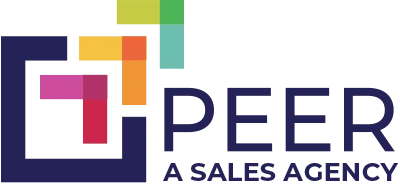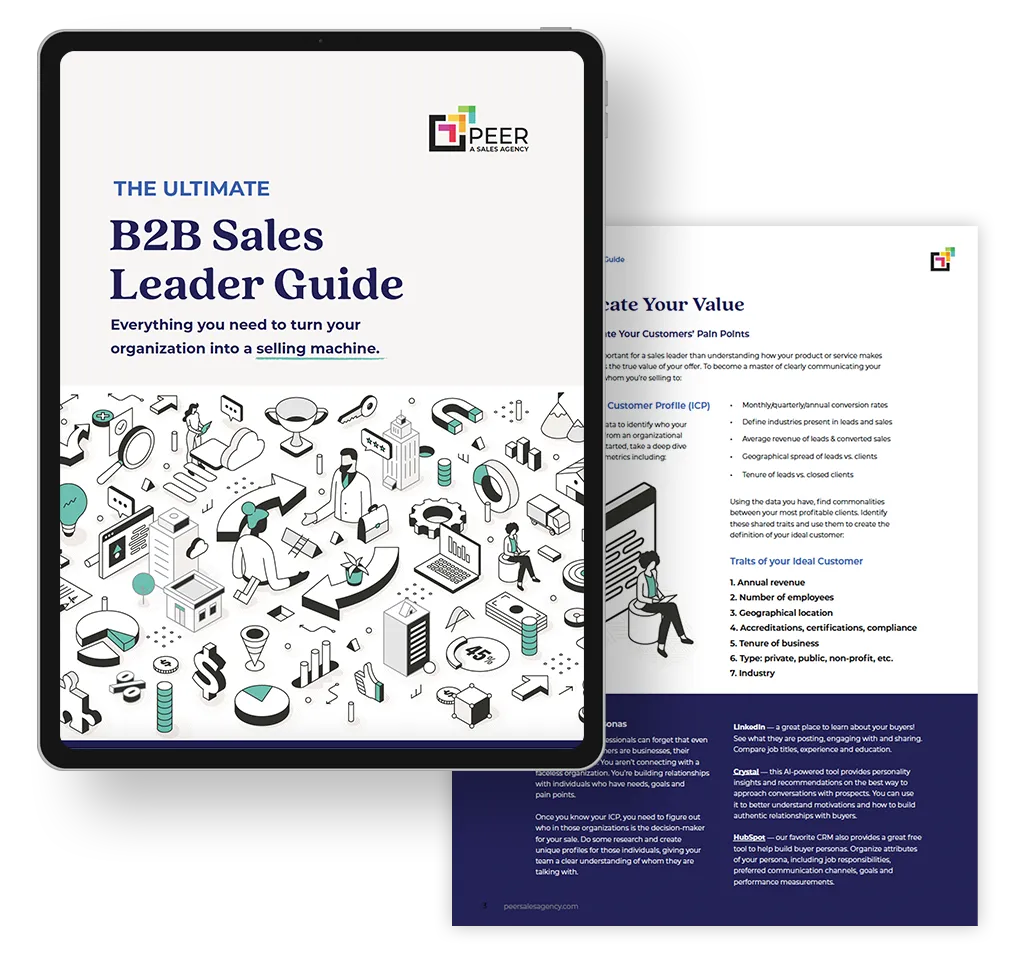From awareness through consideration to decision, your potential customers go through months of research and debate before they’re ready to sign on the dotted line. With the right sales collateral, your sales team can help prospects through that journey, down the sales funnel, right into a closed-won deal.
Here are our must-haves, must-dos, and never-forgets for a bulletproof sales collateral & enablement strategy:
What Counts as Sales Collateral?
Sales collateral is a catch-all term for all the materials and resources sales teams use to support their selling efforts. Think of everything you use in your sales process, like brochures, sales presentation decks, proposals, case studies, whitepapers, blogs, product demos, etc.
Don’t forget about content. It’s more important than ever for B2B businesses to have engaging, helpful, and educational blog and social content ready for discovery online. Simply put, your potential customers want all the information and support they need to make a purchasing decision before they’re ever ready to talk to a sales rep. Tailoring your sales collateral to specific needs at each stage of the B2B buyer’s journey addresses potential customers’ pain points and interests. It helps to build trust and credibility, too.
All of this can align to speed up your sales process. Overall, leveraging sales collateral strategically at each stage of the funnel or buyer’s journey can lead to higher conversion rates, increased market share, and improved customer satisfaction.
Align Your Collateral & Content With Your Buyer Personas
When marketing and selling to other businesses, it’s important to understand who you’re trying to reach at each point in the sales funnel. That’s where buyer personas come in.
A buyer persona is a semi-fictional representation of your ideal customer based on market research and real data from your best customers. Develop at least two personas, your primary buyer and an influencer, to help your entire team, from the C-suite through marketing and sales, understand the specific needs, challenges, and preferences of your potential customers.
Personas are incredibly important when creating sales collateral. For sales collateral to be effective, you have to create content and sales enablement that align with the way your buyer personas want to experience the sales process. Here’s why:
– It helps you create content that resonates with your target audience.
– It allows you to personalize your messaging to better connect with potential customers.
– It helps in building trust and credibility with your audience.
– It increases the likelihood of converting leads into customers.
By getting inside the minds of your buyer personas and tailoring your sales materials to their unique desires and preferences, you’ll be setting your sales team up to captivate potential customers and skyrocket your sales.
Personalize Your Content for the Prospect
According to a study by Salesforce, 76% of customers expect companies to understand their needs and expectations, while 59% say tailored engagement based on past interactions is essential to winning their business.
By leveraging the data and insights you found while crafting your personas, plus the data a great CRM can collect for you, you can personalize your content to feel customized for each reader throughout the buying process.
Personalized content can significantly improve engagement and conversion rates by resonating with your audience on a deeper level. For example, when using Hubspot for your sales and marketing activities, you can use personalization tokens to enrich a standard form email with any data the system knows about your prospect: things like their name, company name, industry, pain points, and website pages visited. Even their birthday! All these data points can be tokenized and inserted into web pages and email communications to streamline operations for your sales team without sacrificing the personal touch.
When potential customers feel understood and valued, they are more likely to engage with your brand and ultimately make a purchase.
Content Distribution Channels by Sales Funnel Stage
When it comes to reaching potential customers with sales collateral, it’s important to use the most effective channels at each stage of the buyer’s journey. Rely on the channels that your persona frequents and trusts.
Top of Funnel / Awareness Stage:
– Use social media posts to share engaging blog posts, infographics, and videos that highlight industry trends and challenges.
– Participate in online forums and communities where your target audience gathers to answer questions and provide helpful information.
Middle of Funnel / Consideration Stage:
– Send targeted email campaigns with whitepapers, case studies, and webinars that showcase your products or services.
– Utilize sponsored content on industry websites or partner with the centers of influence who can showcase your offerings to their audience.
– Develop a strong referral program, complete with referral partner collateral like business overview slicks, email templates, and presentation decks.
Bottom of Funnel / Decision Stage:
– Provide personalized sales materials such as product brochures, pricing guides, and comparison charts on your website and to your sales team to deliver personally.
– Offer demos or free trials of your product or service through digital channels like webinars, social media, landing pages, or virtual product showcases.
Offering the right enablement on the right channel goes a long way to meeting your buyers in the spaces where they’re already looking for advice, solutions, and partnerships.
Types of Sales Collateral to Use in Each Stage of the Buyer’s Journey
Aberdeen Group found that companies with a well-defined sales enablement strategy experience a 13.7% annual increase in deal size. To start moving the needle, your content has to feel relevant to your buyer’s specific situation. Research your target audience to learn about their challenges and what they care about. Tailor your content to address these specific needs. Focus on being helpful to them, and help them solve their problem or determine the real cause of their pain.
Like much else in B2B sales, that’s easier said than done. To keep your sales collateral relevant and interesting, you’ll need to create different types of content at each stage of the buyer’s journey. You’ll also need to arm your sales team with specific types of enablement at each stage.
Awareness Stage Collateral – Top of Funnel
In the awareness stage of the B2B buyer’s journey, your sales strategy needs to incorporate collateral that’s helpful and educational above all else.
This is not the time to sell your services — or to talk about yourself at all. This stage is all about the buyer and their pain point. Your whole purpose at this stage is to educate them about their challenges and mention possible types of solutions. This helps to build a prospect’s trust and position your brand as a knowledgeable resource.
The types of sales collateral that are important in this stage include:
– Blog posts
– Infographics
– White papers
– E-books
– Educational webinars
This type of collateral helps to nurture leads in the earliest stages of the buyer’s journey and sets the stage for more sales-focused content as the prospect moves through the funnel.
Consideration Stage Collateral – Middle of Funnel
As buyers move into the consideration stage, your sales reps must be ready with sales collateral that helps potential customers evaluate the different types of solutions. Focus on building solution awareness and helping potential customers understand the options available. It’s important to offer helpful, interactive tools that help the prospect cut through analysis paralysis and pick a path.
Types of Consideration Collateral:
– Case studies showcasing how your solution has helped similar businesses
– Product comparison guides to help prospects evaluate different options
– White papers that provide in-depth analysis and insights into industry trends or common challenges
– Interactive tools like ROI calculators or solution selection quizzes
At this stage of the buyer’s journey, your most important job is to be a guide, providing the information and support your buyers need to make an informed decision.
Decision Stage Collateral – Bottom of Funnel
Congrats! You’ve got prospects at the bottom of the funnel. Now is the time to prove your expertise, showcase your talent, highlight your differentiators, and dismantle objections.
Types of decision-stage sales collateral include:
– Case studies showcasing successful experiences with similar clients
– Product demonstrations to show how the solution works
– Testimonials from satisfied customers
– Comparison guides to highlight the benefits of choosing your specific solution over the competitors.
Handling objections and providing proof of expertise is crucial at this stage. Your business needs to fully outfit your sales reps with:
– Tailored blog content, addressing common concerns
– Guarantees or warranties
– Data and statistics to back up claims
– Battlecards and playbooks to help bust objections as they arise, in real time
– References, especially in service-based businesses.
Sales Collateral Best Practices & Sales Enablement Strategy
With the right sales collateral, businesses can engage prospective customers, overcome objections, and ultimately close deals more effectively. Here are our top 10 recommendations for building out your sales enablement strategy:
Focus on sales team enablement
You have to empower your sales team with the right sales collateral and training on how to use it. This means giving them the tools they need to have meaningful conversations that add value for potential customers at each stage of the buyer’s journey.
It also means helping your sales team understand which collateral to use and when to use it. Some helpful tools and programs to consider include:
1. Buyer persona training: Teach your team to understand potential customers’ specific needs and pain points at each stage of the buyer’s journey.
2. Content mapping workshops: Guide your team in understanding how different types of content can address the needs and interests of potential customers at each stage.
3. Sales collateral library: Provide easy access to a library of sales collateral such as case studies, whitepapers, and product sheets that address specific pain points and interests of potential customers.
Content creation and maintenance
47% of buyers viewed three to five pieces of content before engaging with a sales rep, according to Demand Gen Report. Your marketing team will be essential to meeting the demand for that content. Creating and maintaining enough sales collateral involves a few key steps:
1. The creation process:
– Identify the target audience and their specific needs and pain points.
– Create content that addresses these needs and pain points.
– Use a messaging matrix to ensure consistency in messaging across all content pieces.
– Review and approve content before it is published or used in sales efforts.
2. The maintenance process:
– Regularly review existing content to ensure it is still relevant and up to date.
– Update content as needed to reflect any changes in products, services, or customer needs.
– Use a brand guide to ensure consistency in design and branding across all content pieces.
– Use buyer personas to tailor content to specific customer segments and their interests.
Sales and Marketing alignment is critical to the success of your business when it comes to creating and maintaining a convincing content library. We recommend you take a deeper dive into that topic – it’s worth the time.
Utilizing CRM technology
Adopting a CRM that facilitates that alignment between sales & marketing teams will go a long way to speeding up your sales cycle and capturing data and insights about your prospects. Here’s how CRM technology can help:
1. At the awareness stage, CRM can help track website visitors and identify potential leads. This allows for targeted content distribution.
2. During the consideration stage, CRM can help sales teams track interactions with potential customers, allowing for personalized follow-ups and tailored content delivery.
3. When it comes to the decision stage, CRM can track and measure the effectiveness of sales collateral to understand what works and what doesn’t.
CRM integrations also enable sales teams to access collateral directly within their CRM system, making it easy to find and share with potential customers. Plus, your CRM can track the opens, usage, view time, and other key statistics related to that collateral.
This ultimately leads to more personalized and impactful interactions with potential customers.
Staying Competitive: Differentiation & Innovation
With 6-10 people on your buying committee, all evaluating different solutions at the same time, standing out from the competition will boost your win rate. To differentiate your sales collateral and enablement, consider these strategies:
– Utilize interactive content: Incorporate innovative approaches such as interactive infographics, videos, or virtual tours to engage potential customers.
– Leverage real customer testimonials: Showcase those real-life success stories to build trust and credibility with potential customers.
– Highlight your unique selling proposition: Clearly communicate what sets your products or services apart from the competition. Differentiators are a key component of your messaging matrix.
To stay ahead of the curve when it comes to leveraging content for sales, consider these innovative approaches and trends:
– Embrace visual storytelling: Utilize compelling, consistent visuals and storytelling to communicate your message in a memorable way.
– Emphasize thought leadership: Position your company, and the people inside it, as industry leaders by providing valuable insights and expertise in your sales collateral, especially blog and social content.
– Utilize data-driven content: Leverage data and analytics to create targeted and personalized content that resonates with potential customers.
By implementing these strategies and innovative approaches, you can set yourself apart from the competition and effectively leverage sales collateral to drive business growth.
Measuring effectiveness and ROI of sales collateral
As with all things, it’s important to measure how effective your sales collateral is at each stage of the buyer’s journey so that you can fill gaps and double down on what’s working. You need to understand what content is resonating with potential customers and what needs improvement.
Here’s how to measure the effectiveness and ROI of your sales collateral:
Awareness Stage:
– Measure website traffic from your content
– Track the number of downloads or views of your top-of-funnel content
Consideration Stage:
– Monitor engagement metrics like time spent on content and click-through rates
– Measure lead conversions from your middle-of-funnel content
Decision Stage:
– Track the number of sales calls or demos booked from your bottom-of-funnel content
– Measure the impact of your content on actual sales and revenue
Key metrics to quantify the impact of your content on conversions and sales include:
– Conversion rates
– Sales pipeline velocity
– Customer acquisition cost
Analytics tools in CRMs like Hubspot can help with this measurement process. By analyzing the data, you can make informed decisions about how to optimize and tailor your sales collateral to better address the specific needs, pain points, and interests of potential customers.
Using sales collateral to build long-term relationships
Sales collateral can begin a business relationship by attracting attention and continuing to engage your prospects as they move through the buyer’s journey and ultimately become customers. Then, highly satisfied customers can become referral partners.
You can create tailored content for each stage of the buyer’s journey, customer lifecycle, and referral partnerships. This can also help to build brand loyalty and advocacy. For example, you can create customer success stories that boost your customer’s brand visibility while showing how your products or services have helped them grow. You can also provide ongoing support and resources to help customers get the most out of their purchase or partnership.
Optimize for mobile-friendly, accessible content
Google reports that 61% of users are unlikely to return to a mobile site they had trouble accessing or reading, emphasizing the importance of mobile optimization for content.
Similarly, if your sales materials don’t look good on a mobile screen, you could miss out on potential customers. It’s also important to make sure that your content meets accessibility standards, since over 1 billion people, globally, live with a disability.
Iterate and Test Continuously
A/B testing different formats, messages, and distribution channels is a good way to learn what works best for your audience at different stages.
Keep in mind that the needs and interests of potential customers can change over time. This is why it’s important to continuously analyze and test your sales collateral. This will help you stay on top of what works best for your audience and adapt to changes in their needs and interests.
Use a single, clear CTA
Each piece of sales collateral should have one CTA, or call to action.
At the awareness stage, a good CTA could be to download a helpful guide or ebook to provide more information about a topic that interests the prospect. This encourages them to learn more about the solutions available.
As prospects move to the consideration stage, a compelling CTA might be to download a demo or schedule a consultation. This allows them to see the product or service in action and understand its benefits.
Finally, at the decision stage, your CTAs are more overt. Here you’re encouraging prospects to make a purchase or sign up for a free trial. This is the final push to convert the prospect into a customer.
Having a clear and compelling CTA is essential because it prompts the reader to take action. It guides them to the next step in their journey and makes it easy for them to move forward.
Integrate Social Proof and User-Generated Content
Authentic experiences shared by existing customers can be very influential in the decision-making process for prospects. When potential customers see positive reviews, testimonials, or case studies from other businesses that have benefitted from a product or service, they are more likely to trust the credibility of the business. These real-life examples can provide valuable insights and help prospects imagine how the product or service might benefit their own business.
“Social proof” is the idea that people are influenced by the actions and opinions of others. Testimonials, reviews, and case studies are the most common pieces of social proof you’ll use in B2B sales. Integrate these proof points throughout your sales collateral, website, and content like blogs and social posts.
User-generated content takes social proof one step further. This is content created by customers, rather than the business itself. Although UGC is more common in B2C sales, self-shot video testimonials shared on social sites and Google reviews are great examples of user-generated content that work well for B2B businesses.
Ready to get started?
Now that you know which types of content and enablement to leverage at each stage of the buyer’s journey, it’s time to map your B2B buyer’s journey.Creating a buyer journey map doesn’t have to be complicated. In fact, it can be a lot of fun. We’ll give you the steps to create your own, and a template to get you started.



